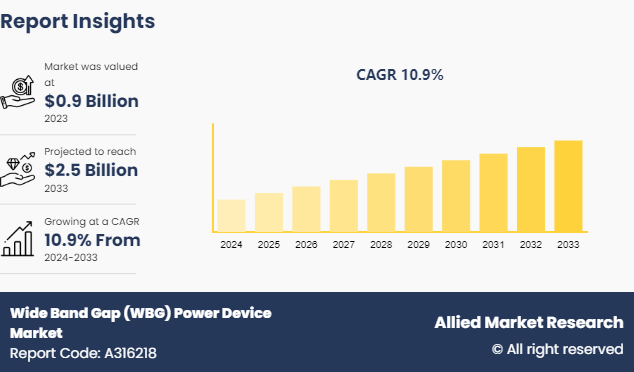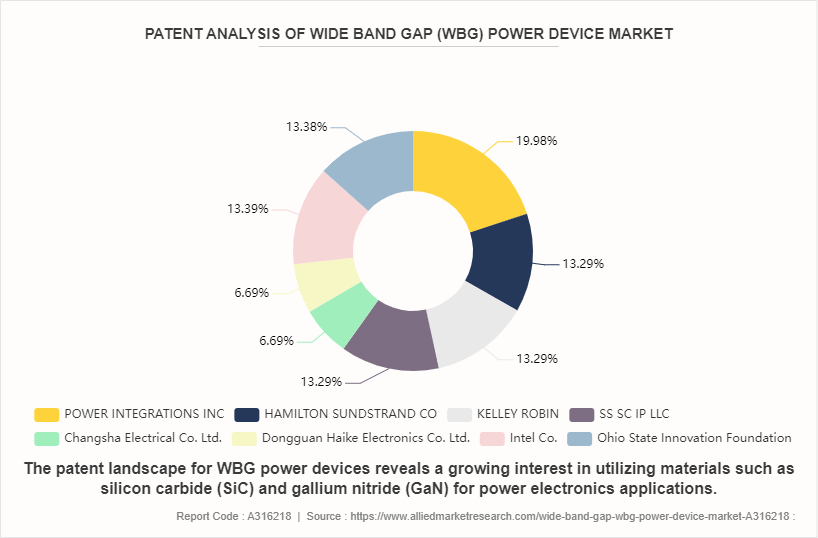Wide Band Gap (WBG) Power Device Market Research, 2033
The global wide band gap (WBG) power device market was valued at $0.9 billion in 2023, and is projected to reach $2.5 billion by 2033, growing at a CAGR of 10.9% from 2024 to 2033.

Market Introduction and Definition:
Wide bandgap power devices (WBG) refer to a category of semiconductor devices that utilize wide bandgap materials such as silicon carbide (SiC) or gallium nitride (GaN) in their construction. The silicon carbide (SiC) and gallium nitride (GaN) offer superior thermal conductivity, enabling efficient heat dissipation and ensuring reliability in demanding applications. These power devices offer superior electrical properties compared to traditional silicon-based semiconductors, enabling higher voltages, frequencies, and temperatures for power electronics applications. WBG power devices exhibit lower conduction losses, faster switching speeds, and higher breakdown voltages, making them ideal for efficient power conversion and control in various industries such as automotive, renewable energy, consumer electronics, and industrial applications.
Key Takeaways:
The report provides competitive dynamics by evaluating business segments, product portfolios, target market revenue, geographical presence, and key strategic developments by prominent manufacturers.
The wide band gap (WBG) power device market is fragmented in nature among prominent companies such as Infineon Technologies AG, ROHM CO., LTD., Mitsubishi Electric Corporation, STMicroelectronics, Fuji Electric Co., Ltd., TOSHIBA CORPORATION, Microchip Technology Inc, Cree LED, GeneSiC, and GaN Systems.
The study contains qualitative information such as the market dynamics (drivers, restraints, challenges, and opportunities) , public policy analysis, pricing analysis, and Porter’s Five Force Analysis across North America, Europe, Asia-Pacific, LAMEA regions.
Latest trends in global wide band gap (WBG) power device market such as undergoing R&D activities, regulatory guidelines, and government initiatives are analyzed across 16 countries in 4 different regions in wide band gap (WBG) power device industry.
More than 3, 000 wide band gap (WBG) power device-related product literatures, industry releases, annual reports, and other such documents of key industry participants along with authentic industry journals and government websites have been reviewed for generating high-value industry insights for global wide band gap (WBG) power device market.
Key Market Dynamics:
The surge in demand for high-efficiency power electronics is a primary driver that propels the growth of the WBG power devices market. These devices offer superior performance compared to traditional silicon-based counterparts, particularly in terms of efficiency, power density, and thermal management. As industries strive for energy conservation and sustainable practices, there is a rise in need for power electronics solutions that minimize energy losses and maximize conversion efficiency. WBG materials such as silicon carbide (SiC) and gallium nitride (GaN) enable the development of power devices capable of operating at higher frequencies and temperatures, thereby enhancing overall system efficiency. In addition, industries increasingly seek compact and lightweight power electronics solutions to meet the demands of modern applications such as data centers, telecommunications, and aerospace. These devices offer a higher power density and reduced form factor compared to traditional silicon-based devices, making them well-suited for space-constrained environments.
The expansion of renewable energy integration is a significant driver that propels the growth of the WBG power devices market. As the global transition toward renewable energy sources accelerates, there is an upsurge in demand for more efficient and reliable power electronics to facilitate the integration of renewable energy into existing power grids. WBG power devices, with their superior performance characteristics, are increasingly recognized as essential components in renewable energy systems. Moreover, the compact size and lightweight nature of WBG power devices make them well-suited for renewable energy applications, where space constraints are common, such as solar inverters and wind turbine converters. Their smaller form factor enables more streamlined system designs and reduces the overall footprint of renewable energy installations. All these factors drive the growth of wide band gap (WBG) power device market.
However, the high initial costs and manufacturing expenses restrain the growth of WBG power devices market. Installation of WBG power devices requires substantial investments in research, development, and manufacturing infrastructure. The fabrication processes involved in producing WBG semiconductors are complex and require sophisticated equipment, specialized materials, and skilled labor, all of which contribute to higher production costs. In addition, the initial investment in transitioning from traditional silicon-based devices to WBG technology is prohibitive for many companies, particularly smaller enterprises with limited financial resources. Thus, the high initial costs and manufacturing expenses hinder the growth of wide band gap (WBG) power device market.
Advancements in manufacturing processes represent a significant opportunity for the wide band gap (WBG) power device market. As technology continues to evolve, manufacturers are exploring novel methods and techniques to enhance the production efficiency and quality of WBG devices. These advancements encompass various aspects of manufacturing, including materials synthesis, device fabrication, and packaging. These advancements in manufacturing processes drive innovation and contribute to cost reduction and scalability, making WBG power devices more accessible to a broader range of applications. With improved manufacturing efficiency and economies of scale, the cost per unit of WBG devices is expected to decrease, further stimulating market growth.

Over the past decade, there has been a significant increase in patent filings related to WBG power devices, indicating heightened R&D activities in this field. Key patent holders in the WBG power devices market include companies such as POWER INTEGRATIONS INC, HAMILTON SUNDSTRAND CO, KELLEY ROBIN, SS SC IP LLC, and others that hold significant patent portfolios covering various aspects of WBG power devices.
Market Segmentation:
The wide band gap (WBG) power device market report is segmented into type, application, and region. By type, the market is bifurcated into GaN and SiC. As per application, the market is divided into communication, automotive, consumer electronics, aerospace, healthcare, and others. Region-wise the market is analyzed across North America, Europe, Asia-Pacific, and LAMEA.
Competitive Landscape:
The major players operating in the WBG power devices market include includes Infineon Technologies AG, ROHM CO., LTD., Mitsubishi Electric Corporation, STMicroelectronics, Fuji Electric Co., Ltd., TOSHIBA CORPORATION, Microchip Technology Inc, Cree LED, GeneSiC, and GaN Systems.
Recent Key Strategies and Developments:
In January 2024, Renesas Electric Corporation entered into a definitive agreement to acquire Transphorm Inc., a leading manufacturer of GaN (gallium nitride) -powered WBG power devices. This strategic acquisition may enhance the product portfolio of Renesas Electric Corporation for GaN type WBG power devices.
In November 2023, MinebeaMitsumi acquired semiconductor business of Hitachi. This strategic acquisition is expected to enhance the product portfolio of MinebeaMitsumi for semiconductors including WDB power devices.
Regional/Country Industry Outlook:
The Asia-Pacific region is home to some of the world's fastest-growing economies, driving rapid industrialization and urbanization. Industries such as automotive, manufacturing, telecommunications, and consumer electronics have expanded, which has led to a rise in demand for high-performance power electronics solutions. WBG power devices offer advantages such as higher efficiency, faster switching speeds, and improved thermal performance compared to traditional silicon-based devices, making them well-suited for various industrial applications.
Furthermore, many countries in Asia-Pacific have accelerated their transition toward renewable energy sources such as solar and wind power to reduce dependence on fossil fuels and mitigate climate change. WBG power devices play a crucial role in renewable energy systems by enhancing the efficiency and reliability of power conversion and grid integration. Applications include solar inverters, wind turbines, energy storage systems, and grid infrastructure.
Moreover, the Asia-Pacific region is a major market for electric vehicles (EVs) , driven by government incentives, environmental regulations, and consumer demand for cleaner transportation solutions. WBG power devices enable more efficient and compact power conversion systems in EVs, extending driving range, reducing charging times, and improving overall performance.
Key Industry Trends:
According to an article published by Keysight in February 2024, the use of Gallium Nitride (GaN) acts as a catalyst that drive the adoption of WBG power devices in various end-use sector owing to various significant characteristics such as faster switching speeds, higher thermal resistance, and higher voltages.
Advancements in manufacturing and assembly of WBG power devices have increased the driving range of electric vehicles (EVs) by 6%.
A recent study conducted by the International Renewable Energy Agency has found that the use of GaN transistors has reduced around 100 metric tons of carbon dioxide emissions from data centers annually. This has boosted the potential applications of WBG power devices across data centers; thus, fueling market growth.
Key Sources Referred:
National Promotion and Facilitation Agency
International Energy Agency
International Renewable Energy Agency
U.S. Development Authority
Invest In India
The Economic Times
Science Direct
Press Information Bureau
Key Benefits For Stakeholders:
- This report provides a quantitative analysis of the market segments, current trends, estimations, and dynamics of the wide band gap (WBG) power device market analysis from 2023 to 2033 to identify the prevailing wide band gap (WBG) power device market opportunities.
- The market research is offered along with information related to key drivers, restraints, and opportunities.
- Porter's five forces analysis highlights the potency of buyers and suppliers to enable stakeholders make profit-oriented business decisions and strengthen their supplier-buyer network.
- In-depth analysis of the wide band gap (WBG) power device market segmentation assists to determine the prevailing market opportunities.
- Major countries in each region are mapped according to their revenue contribution to the global market.
- Market player positioning facilitates benchmarking and provides a clear understanding of the present position of the market players.
- The report includes the analysis of the regional as well as global wide band gap (WBG) power device market trends, key players, market segments, application areas, and market growth strategies.
Wide Band Gap (WBG) Power Device Market Report Highlights
| Aspects | Details |
| Market Size By 2033 | USD 2.5 Billion |
| Growth Rate | CAGR of 10.9% |
| Forecast period | 2024 - 2033 |
| Report Pages | 350 |
| By Type |
|
| By Application |
|
| By Region |
|
| Key Market Players | GaN systems, Fuji Electric Co., Ltd., Infineon Technologies AG, Microchip Technology Inc., Mitsubishi Electric Corporation, TOSHIBA CORPORATION, Cree LED, Inc., ROHM CO., LTD., GeneSiC, STMicroelectronics |
Loading Table Of Content...



